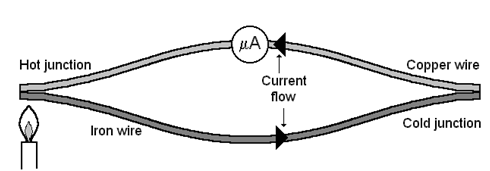Production of electricity by heat:
The Seebeck effect - the thermocouple. When two different metals are brought into contact with one another, it is found that electrons can leave one of the metals more easily than they can leave the other metal. This is because of the difference in what is known as the work function of the two metals. Since electrons leave one metal and are gained by the other, a potential difference exists between the two metals; thus the emf is known as the contact potential or contact emf.
If two metals, say copper and iron, are joined at two points as shown in the diagram above, and both junctions are at the same temperature, the contact potentials cancel each other out and no current flows in the loop of wire. However, Thomas Johann Seebeck (1770 -1831) discovered that if the two junctions are kept at different temperatures, there is a drift of electrons around the circuit, that is to say, current flows.

The magnitude of the voltage produced by this method is small - only a few millivolts per degree centigrade - but it is sufficient to be measured. The current flow is a measure of the difference in temperature between the 'hot' junction and the 'cold' junction.
Each junction is known as a thermocouple and if a number of thermocouples are connected in series so that alternate junctions are 'hot' and the other junctions are 'cold', the total emf is increased; this arrangement is known as a thermopile.
On aircraft, thermocouples are used for temperature measurement and will be examined in more detail at a later date.